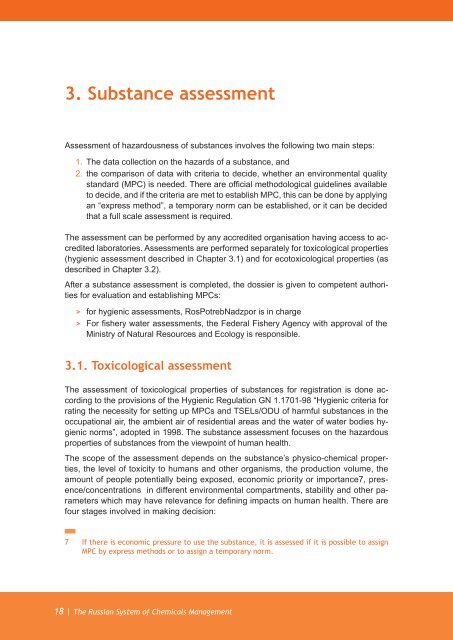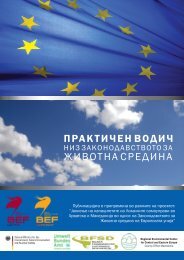The Russian system of chemicals management - Bef-de.org
The Russian system of chemicals management - Bef-de.org
The Russian system of chemicals management - Bef-de.org
You also want an ePaper? Increase the reach of your titles
YUMPU automatically turns print PDFs into web optimized ePapers that Google loves.
3. Substance assessment<br />
Assessment <strong>of</strong> hazardousness <strong>of</strong> substances involves the following two main steps:<br />
1. <strong>The</strong> data collection on the hazards <strong>of</strong> a substance, and<br />
2. the comparison <strong>of</strong> data with criteria to <strong>de</strong>ci<strong>de</strong>, whether an environmental quality<br />
standard (MPC) is nee<strong>de</strong>d. <strong>The</strong>re are <strong>of</strong>ficial methodological gui<strong>de</strong>lines available<br />
to <strong>de</strong>ci<strong>de</strong>, and if the criteria are met to establish MPC, this can be done by applying<br />
an “express method”, a temporary norm can be established, or it can be <strong>de</strong>ci<strong>de</strong>d<br />
that a full scale assessment is required.<br />
<strong>The</strong> assessment can be performed by any accredited <strong>org</strong>anisation having access to accredited<br />
laboratories. Assessments are performed separately for toxicological properties<br />
(hygienic assessment <strong>de</strong>scribed in Chapter 3.1) and for ecotoxicological properties (as<br />
<strong>de</strong>scribed in Chapter 3.2).<br />
After a substance assessment is completed, the dossier is given to competent authorities<br />
for evaluation and establishing MPCs:<br />
>><br />
>><br />
for hygienic assessments, RosPotrebNadzpor is in charge<br />
For fishery water assessments, the Fe<strong>de</strong>ral Fishery Agency with approval <strong>of</strong> the<br />
Ministry <strong>of</strong> Natural Resources and Ecology is responsible.<br />
3.1. Toxicological assessment<br />
<strong>The</strong> assessment <strong>of</strong> toxicological properties <strong>of</strong> substances for registration is done according<br />
to the provisions <strong>of</strong> the Hygienic Regulation GN 1.1701-98 “Hygienic criteria for<br />
rating the necessity for setting up MPCs and TSELs/ODU <strong>of</strong> harmful substances in the<br />
occupational air, the ambient air <strong>of</strong> resi<strong>de</strong>ntial areas and the water <strong>of</strong> water bodies hygienic<br />
norms”, adopted in 1998. <strong>The</strong> substance assessment focuses on the hazardous<br />
properties <strong>of</strong> substances from the viewpoint <strong>of</strong> human health.<br />
<strong>The</strong> scope <strong>of</strong> the assessment <strong>de</strong>pends on the substance’s physico-chemical properties,<br />
the level <strong>of</strong> toxicity to humans and other <strong>org</strong>anisms, the production volume, the<br />
amount <strong>of</strong> people potentially being exposed, economic priority or importance7, presence/concentrations<br />
in different environmental compartments, stability and other parameters<br />
which may have relevance for <strong>de</strong>fining impacts on human health. <strong>The</strong>re are<br />
four stages involved in making <strong>de</strong>cision:<br />
7 If there is economic pressure to use the substance, it is assessed if it is possible to assign<br />
MPC by express methods or to assign a temporary norm.<br />
18 | <strong>The</strong> <strong>Russian</strong> System <strong>of</strong> Chemicals Management



